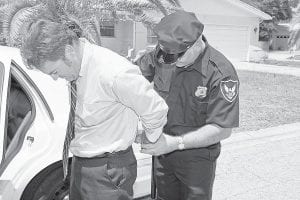Curt Mowers of the Minnesota State Patrol reminds drivers that alcohol only leaves your system with time. If you drink heavily and go to sleep for only a short time before heading out in the morning, alcohol will still be in your system and you are very likely impaired. You are more at risk for crashing and hurting yourself or others.

Sgt. Curt Mowers of the Minnesota State Patrol gets asked a lot of questions—about use of headlights, bike safety, turn signals, pedestrian right of way, and more. Mowers was recently asked a question that he felt was important to share with the public. Mowers was asked: After a night out drinking with my friends, I was arrested the following morning for drunk driving on my way to work. How is this possible?
Mowers replied: Alcohol-related crashes and DWI arrests do happen in the morning, we see it all the time. The number of those DWI arrests does not compare to what occurs on Friday, Saturday and Sunday, but surely something to be looked at and aware of, as we are going to have more crashes when we have more cars on the road and drivers are in a hurry. If we add fatigued drivers with alcohol still in their system from the night before, crashes will increase.
Mowers shared some very basic facts about alcohol in your system. Keep in mind there are some factors that change the amount of alcohol absorbed: weight, food, gender, just to name a few, however Mowers said this can still serve as an accurate guide.
The most important thing to know is that alcohol only leaves your system with time. The “average” alcohol dissipation in humans is said to be about 0.015 percent per hour. A cup of coffee or a few hours of sleep will not dissipate alcohol faster; one drink will leave your system in approximately one and onehalf hour.
Now “one drink” is not a three- or fourshot martini or a long-pour cocktail. One drink for this formula is: one 12-ounce domestic beer, 4 ounces of domestic wine, or one shot or less of 80 proof alcohol in a cocktail. If you go beyond this definition of “one drink,” more alcohol will be in your system and the proportional amount of time will be needed before it leaves your system.
If you drink heavily and go to sleep for only a short time before heading out in the morning, alcohol will still be in your system and you are very likely impaired, thus, you are more at risk for crashing and hurting yourself and/or others. Often, in these scenarios, fatigue is a huge factor weighing in also.
Sleep with alcohol in your system is not good sleep and fewer than seven or eight hours a night is not recommended if trying to avoid fatigue. Again, there is no magic pill to take—only time will get the alcohol out of your system and it is important to consider this when making your plans and designating your sober driver. There is zero tolerance for impaired drivers on our roadways, stresses Mowers.
DUI facts and figures
. The state’s first DWI law enacted was in 1911.
. When baby boomers began to drive in the 1960s more than 60 percent of traffic
deaths were due to drinking and driving. This started to decrease in the 1980s.
Currently about 30 percent of all fatalities are alcohol related.
. The earliest record of traffic deaths was in 1910, with 23 fatalities. Systematic
record-keeping on crashes started much later in the 1930s.
. Over 570,191 Minnesotans (10.7 percent) have one or more DWIs on record. Of
licensed drivers in the state, 1 in 7 have one or more incidents on record, 1 in 17
have two or more and 1 in 30 have three or more. Startlingly, 1,265 Minnesotans
have 10 or more impaired driving incidents.
. In 2011, there were 29,257 impaired driving incidents, with 1,903 being underage
drivers.
. In 55 percent of impaired driving incidents the violators are 20 to 34 year olds.
Males committed 73 percent of the incidents.
. Of all violators, 60 percent had no prior alcohol incidents on record, leaving 40
percent as re-offenders. Of those who incur a second violation, half of them will
go on to a third, half with a third incident will incur a fourth. Impaired driving
incidents remain permanently on a violator’s record.
. Mahnomen, Mille Lacs, Clearwater, Cass and Becker counties have the highest
percentage of impaired driving incidents on record and Stevens, Rock, Lincoln,
Carver and Washington have the lowest.
. Fridays account for 16 percent of all alcohol incidents, Saturdays for 27 percent
and, finally, Sunday for 23 percent.
Information taken from Minnesota Motor Vehicle Impaired Driving Facts; 2011 –
Office of Traffic Safety, MN Department of Public Safety


Loading Comments